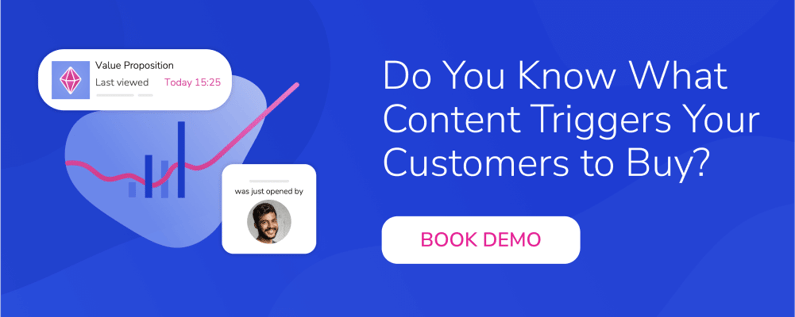With countless brands vying for consumer attention, capturing and maintaining interest is an important factor in creating relationships and fostering loyalty. It can also be the deciding factor in closing a deal.
But what exactly does buyer engagement mean? How does it differ from customer engagement? And most importantly, why should you care? This blog will break down the complexities of buyer engagement, exploring its significance, key metrics, and actionable strategies.
By the end of this read, you'll have a solid understanding of buyer engagement and how to leverage it to propel your business forward.
What you'll find in this blog:
What is Buyer Engagement?
Buyer engagement is the ongoing connection and interaction between a potential customer and your business. It’s a dynamic process that starts from the moment someone becomes aware of your brand.
Through these interactions, you start understanding your audience, speaking their language, and providing value at every stage of their journey.
Through consistent and positive touchpoints, trust is built, fostering a deeper connection. This trust is the cornerstone of guiding potential customers through their buying journey, from initial interest to purchase and beyond. Every touchpoint matters in shaping their perception of your brand.
Buyer vs. Customer Engagement: Key Differences
So what’s the difference between buyer and customer engagement?
Customer engagement focuses on the relationship between a business and its existing customers. It's about nurturing loyalty, encouraging repeat purchases, and building advocacy.
Buyer engagement, on the other hand, is about cultivating relationships with potential customers. It's about capturing their attention, guiding them through the buying journey, and converting them into loyal customers.
While both are crucial, buyer engagement sets the stage for long-term customer relationships.
5 Reasons Why You Should Track Buyer Engagement
Understanding the nuances of buyer engagement is crucial, but it's equally important to measure its impact. Tracking buyer engagement provides invaluable insights into your audience, helping you optimize your sales and marketing efforts.
Let's explore some reasons why you should prioritize tracking buyer engagement.
1. Increased Sales and Revenue
Closely monitoring buyer engagement will help you identify which marketing channels and campaigns are most effective in driving conversions. This data-driven approach allows you to allocate resources wisely and optimize your sales funnel.
2. Improved Customer Lifetime Value (CLTV)
Fostering strong buyer relationships leads to increased customer loyalty and repeat purchases. By tracking engagement metrics, you can identify customers with high potential value and tailor your marketing efforts accordingly. This helps you maximize the lifetime value of your customers.
3. Stronger Brand Loyalty and Advocacy
Engaged buyers are more likely to become brand advocates. By consistently delivering exceptional experiences, you encourage customers to share their positive impressions with their networks, leading to increased brand awareness and trust.
4. Valuable Insights and Feedback
Tracking buyer engagement provides a wealth of information about your target audience. By analyzing their behavior and preferences, you can gain valuable insights to refine your product offerings, improve your marketing messages, and enhance overall customer satisfaction.
5. Competitive Advantage
Buyer engagement tracking empowers you with a strategic advantage. By analyzing engagement data, you can uncover hidden opportunities, anticipate customer needs before they arise, and personalize the buyer journey to leave a lasting impression. This proactive approach sets you apart from competitors and positions your brand for long-term success.

How to Track Buyer Engagement: 5 Steps
To effectively measure and improve buyer engagement, it's essential to implement a robust tracking system. By leveraging various tools and platforms, you can gather valuable data on buyer behavior, preferences, and interactions.
Here's a step-by-step guide to building a comprehensive tracking system for buyer engagement:
1. Choose the Right Tools
Selecting the appropriate tools is crucial for efficient tracking and data visualization. The right tools empower you to gather, analyze, and leverage data effectively. Here's a breakdown of essential tool categories:
- Analytics platforms: Google Analytics, Adobe Analytics, and HubSpot offer comprehensive website traffic and user behavior insights.
- CRM software: Salesforce, HubSpot, and Zoho help manage customer interactions, track sales pipelines, and analyze customer data.
- Social media management tools: Hootsuite, Social Champ, Buffer, and Sprout Social provide data on social media engagement and sentiment.
- Email marketing platforms: Mailchimp, Constant Contact, and Klaviyo offer metrics on email open rates, click-through rates, and conversions.
- Survey tools: Titan Survey, SurveyMonkey, Qualtrics, and Typeform enable gathering qualitative feedback from customers.
- Heatmapping tools: Hotjar and Crazy Egg visualize user behavior on websites, revealing areas of interest and frustration.
When selecting tools, consider factors such as cost, features, ease of use, and integration capabilities. A well-chosen toolset will provide the foundation for effective buyer engagement tracking.
2. Integrate Data Sources
Combining data from various channels creates a holistic understanding of the customer journey. Automation tools or custom integrations can help connect different platforms. This unified view allows for a deeper analysis of buyer behavior and preferences, revealing patterns, trends, and opportunities for improvement.
For example, by combining website traffic data with CRM information, you can identify which marketing channels drive the most high-quality leads.
Additionally, integrating social media data can help you understand how customer sentiment impacts sales and customer loyalty. A comprehensive data integration strategy empowers you to make informed decisions based on a complete picture of your customers.
3. Set Clear Objectives
Why bother setting clear objectives? Think of it like planning a road trip. Without a destination in mind, you're just driving around aimlessly.
- Setting clear objectives for your tracking efforts gives you a direction and a purpose. It ensures that you're collecting the right data and using it to make informed decisions. Here’s how to start:
- Start by defining your overall business goals. What do you want to achieve? Increase revenue? Improve customer satisfaction?
- Break down those goals into specific, measurable, achievable, relevant, and time-bound (SMART) objectives. For example, "Increase website traffic by 20% in the next quarter" is a SMART objective.
- Consider your target audience and their needs. What information do you need to better understand them?
- Be realistic and prioritize your objectives. You don't want to overwhelm yourself with too many metrics to track.
|
Examples of clear objectives: ✅ Increase lead generation by 30% in the next six months |
4. Establish Key Metrics
Identifying and tracking relevant metrics is vital for measuring buyer engagement. Key metric categories include:
- Website Traffic and Engagement Metrics: Bounce rate, average session duration, pages per session, scroll depth, and click-through rate provide insights into website performance.
- Social Media Engagement Metrics: Impressions, reach, engagement rate, click-through rate, share of voice, sentiment analysis, and follower growth offer valuable data on social media performance.
- Email Engagement Metrics: Open rate, click-through rate, click-to-open rate, bounce rate, unsubscribe rate, and conversion rate help measure email campaign effectiveness.
- Sales Content Engagement Metrics: Content downloads, time spent on content, content shares, lead generation, and conversion rates indicate how well sales content resonates with the audience.
- Conversion Rate and Sales Metrics: Conversion rate, customer acquisition cost, average order value, sales cycle length, and win rate measure overall sales performance.
5. Analyzing, Reporting, and Refining
Regularly analyzing data to identify trends and patterns is crucial for optimizing buyer engagement strategies. Creating informative reports and dashboards helps communicate insights to stakeholders. Continuously refine the tracking system based on new findings to ensure its effectiveness in supporting business goals.
Think of data analysis as a detective story. You're looking for clues about your audience's behavior, preferences, and pain points. Use data visualization tools to bring your findings to life. Create engaging reports and dashboards that tell a compelling story about your audience. Share these insights with your team to spark conversations and inspire action.
Remember, data is a living, breathing thing. It changes over time. Keep an eye on your metrics and adjust your tracking strategy as needed. What worked last month might not work next month. Stay curious, keep experimenting, and never stop learning from your data.

Showell: Track and Measure Sales Content Engagement
So, you’ve got a good grasp on tracking buyer engagement, but let’s talk about making it easier. Enter Showell: it’s a tool that doesn’t just track buyer engagement with your sales content; it’s like a personal assistant for your sales team, helping them stay organized and effective.
With Showell, you’re not just tracking; you’re understanding how your buyers interact with your content. With the insights gained from engagement analytics, sales teams can identify clear interests in specific sales materials, anticipate buyer needs, and even spot new stakeholders involved in the decision-making process.
Plus, Showell doesn’t just track - it also houses all your sales content in one place. No more digging through endless folders or outdated materials. It's your go-to spot for the latest and greatest sales content.
Showell could be the missing piece your sales team needs to boost their performance and elevate buyer engagement. Book a demo with us by clicking the banner below to see it in action yourself!
Learn more about Sales Enablement:




